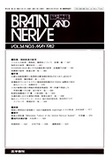Japanese
English
- 有料閲覧
- Abstract 文献概要
- 1ページ目 Look Inside
抄録 症例:38歳,女性。右前頭葉のglioblastoma multiformeの診断にて,腫瘍の亜全摘施行後,放射線照射,化学療法,免疫療法を受けたが,全経過3年6ヵ月で死亡し,剖検が施行された。腫瘍は右前頭葉を占拠し,脳梁を通じて左前頭葉にも浸潤しており,小脳・脳幹・脊髄のクモ膜下腔に腫瘍の播種がみられた。組織学的には,腫瘍は主としてastrocyte様細胞から成り,oligodendroglia様細胞,異型性の強い細胞を混じ,ependymoma様の部分もみられたが,真のrosetteは認められず, anaplastic gliomaと診断した。また,放射線照射野内の腫瘍組織には,典型的な放射線壊死と考えられる広範な凝固壊死が存在していた。さらに,照射野内には,腫瘍組織とは独立して,肥大性astrocyteの増生がびまん性にみられた。他方,脳幹部軟膜下白質には,髄鞘と軸索の消失を伴う海綿状変性がみられた。炎性細胞やグリオーシスは伴っておらず,成因は不明であるが,放射線や抗癌剤の影響は考えにくく,脳底部に血性貯留物が存在したことや腫瘍の髄膜播種があることから,静脈灌流障害や軟膜透過性異常によるものと推定された。
A histopathological study on an autopsy case of 38-year-old female who had suffered from huge glioma and received radiation therapy as well as operation and chemotherapy was reported.
The tumor mainly involved the right frontal lobe and partially invaded to the left cerebral hemisphere. Subarachnoidal dissemination of tumor cells was noticed in cerebellum, brain stem and spinal cord.
Under the microscope the tumor was mainly consisted of astrocytic tumor cells, while oligoden-drocytic ones and those with anaplastic or bizarre nuclei were observed among them. Though epen-dymomatous appearance was partially seen, no true rosette was found. From these findings the tumor was histologically diagnosed as anaplastic glioma.
Simultaneously, there was massive coagulative necrosis which was limited to the irradiated area in the tumor tissue and surely attributable to irradia-tion. In addition, proliferation of gemistocytic astrocytes which was independent of glioma itself was widely observed in the field of irradiation.
Another remarkable finding was spongiform degeneration which was located in the subpial area of brain stem including degenerative products of myelin sheaths and axons with neither inflam-matory changes nor gliosis. In some papers it is suggested that such a lesion has something to do with irradiation or chemotherapy. But in our case this lesion was found in non-irradiated area and no intramedullary injection of chemical agents was performed. Further, the distribution of this lesion was for the most part restricted to the domain of the pontine cistern which had been huge owing to stagnant hemorrhagic fluid. Therefore, it is highly probable that this lesion was caused by the abnormal pia-glial barrier.

Copyright © 1982, Igaku-Shoin Ltd. All rights reserved.


